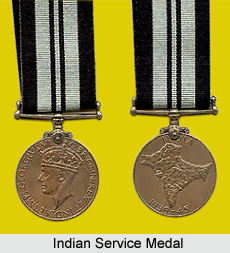 The Indian Service Medal of 1939- 1945 was a British decoration and campaign medal that was awarded to those individuals and leaders who had served in the Armed Forces during the Second World War. It was granted as an honour to the awarded to those who had served in the Armed Forces. The Indian Service Medal of 1939- 1945 replaced the Defence Medal. This medal was instituted on 6 June, 1946 During World War II, the country was still under the rule of the British Empire in India and the British Commonwealth. Thus various awards and medals were bestowed by the British authorities to those native and foreign individuals who provided loyal service to the British forces.
The Indian Service Medal of 1939- 1945 was a British decoration and campaign medal that was awarded to those individuals and leaders who had served in the Armed Forces during the Second World War. It was granted as an honour to the awarded to those who had served in the Armed Forces. The Indian Service Medal of 1939- 1945 replaced the Defence Medal. This medal was instituted on 6 June, 1946 During World War II, the country was still under the rule of the British Empire in India and the British Commonwealth. Thus various awards and medals were bestowed by the British authorities to those native and foreign individuals who provided loyal service to the British forces.
The Indian Service Medal of 1939- 1945 was awarded for 3 years of non-operational service in the Indian Forces between 3 September 1939 and 2 September 1945, except those who were permitted to the British Defence Medal. The ribbon colours of the Indian Service Medal represented the Order of the Indian Empire and the Order of the Star of India. The Order of the Star of India (The Most Exalted Order of the Star of India) and the Order of the Indian Empire (The Most Eminent Order of the Indian Empire) were orders of chivalry established by Queen Victoria in the year 1861 and 1878 respectively.
The Indian Service Medal of 1939- 1945 was circular cupro-nickel medal with a diameter of 36mm. The obverse on the medal contained the legend GEORGIVS VI D: G: BR: OMN: REX ET INDIAE IMP (George VI by the grace of God King of Great Britain and Emperor of India). The effigy of King George VI was also crowned on it. On the reverse of the British campaign medal a relief of the British Indian map and the words INDIA and 1939-45 were imprinted. The ribbon of the Indian Service Medal represented the colours of the Order of the Star of India and the Order of the Indian Empire. The prestigious medal did not contain any claps. The Indian Service Medal of 1939- 1945 was awarded by the British administration of India for Campaign service.



















